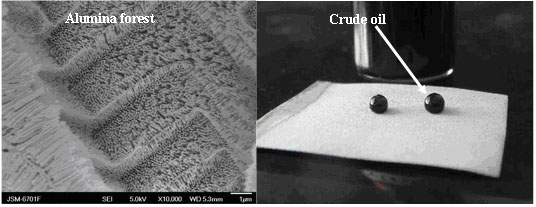|
Surfaces with extreme wettability have been a hot studied area for several years due to its strong application potentials. However, oil repellency, especially to those with extremely low surface tension, has always been a challenge in this area and is rarely reported so far. The research group led by Prof Feng Zhou and Prof Weimin Liu in State Key Lab of Solid Lubrication, created superamphiphobic surfaces with engineering aluminum and alloys for the first time with an industrial compatible approach. The excellent properties are exhibited by its superrepellency to almost all liquids found in lab except fluoro-containing liquids. Beyond that, the surfaces display good anti-waxing, easy removal of wax property. The work has recently been published in ChemCommun(2009, 1043) and highlighted by Chemical Technology ((http://www.rsc.org/Publishing/ChemTech/Volume/2009/04/ nanowire_forests.asp). Most important characteristics about the materials are not only its excellent superamphiphobicity, but also the easy fabrication approach using conventional industrial technique at low cost and easy processibility etc. Superamphiphobic polymeric materials, i.e. polyurethane, polyethylene etc, are developed by implementing complex micro/nano structures into these polymer materials. These materials are prospect for applications in, i.e., self-cleaning components, oil transport pipeline, oil storage, oil anticreeping etc
Source: State Key Laboratory of Solid Lubrication
Figure. Alumina nanowire forest and superrepellency to crude oil
|
